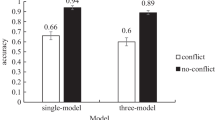Abstract
The following presents the results of an investigation of strategies and preferences in human reasoning about quantified spatial relational assertions. An empirical study revealed a clear preference effect for specific models: The initially constructed model depends on the number of mental model operations. The participants’ strategies can be classified as follows: (1) Models with grouped elements are preferred; (2) Models are constructed according to a parsimonious representation strategy. Systematic reasoning errors and illusions can be identified with logical connectors (AND: 86 % valid initial models; XOR: 47 %; Wilcoxon z = 4.6; p < .001). Error rates were smallest when using two universal quantifiers (All–All), they increase significantly when using one (Some–All; All–Some) and again using none (Some–Some) (Page’s L = 436; z = 3.40 p < .001). Although the different assertions allowed for multiple situations, the difficulty can be traced back to specific quantifiers and logical connectors.



Similar content being viewed by others
References
Bucciarelli M, Johnson-Laird PN (1999) Strategies in syllogistic reasoning. Cogn Sci 23(3):247–303. doi:10.1016/S0364-213(99)00008-7
Byrne RMJ, Johnson-Laird PN (1989) Spatial reasoning. J Mem Lang 28:564–575. doi:10.1016/0749-596X(89)90013-2
Chater N, Oaksford M (1999) The probability heuristics model of syllogistic reasoning. Cogn Psychol 38(2):191–258. doi:10.1006/cogp.1998.0696
Johnson-Laird PN (2001) Mental models and deduction. Trends Cogn Sci 5(10):434–442. doi:10.1016/S1364-6613(00)01751-4
Johnson-Laird PN, Byrne RMJ, Tabossi P (1989) Reasoning by model: the case of multiple quantification. Psychol Rev 96(4):658–673. doi:10.1037/0033-295X.96.4.658
Johnson-Laird PN, Lotstein M, Byrne RMJ (2012) The consistency of disjunctive assertions. Mem Cogn. doi:10.3758/s13421-012-0188-2
Knauff M, Rauh R, Schlieder C (1995) Preferred mental models in qualitative spatial reasoning: a cognitive assessment of Allen’s calculus. Proceedings of the 17th annual conference of the Cognitive Science Society. Erlbaum, Mahwah, pp 200–205
Ragni M, Knauff M, Nebel B (2005) A computational model for spatial reasoning with mental models. In: Bara B, Barsalou B, Bucciarelli M (eds) Proceedings of the 27th annual conference of the Cognitive Science Society. Erlbaum, Mahwah, pp 1064–1070
Ragni M, Fangmeier T, Webber L, Knauff M (2007) Preferred mental models: how and why they are so important in human reasoning with spatial relations. In: Freksa C, Knauff M, Krieg-Brückner B, Nebel B, Barkowsky T (eds) Spatial cognition V: reasoning, action, interaction. Springer, Berlin, pp 175–190
Rauh R, Hagen C, Knauff M, Kuß T, Schlieder C, Strube G (2005) Preferred and alternative mental models in spatial reasoning. Spat Cogn Comp 5:239–269. doi:10(1080/13875868).2005.9683805
Rips LJ (1994) The psychology of proof: deductive reasoning in human thinking. The MIT Press, Cambridge
Stenning K, Van Lambalgen M (2008) Human reasoning and cognitive science. MIT Press, Cambridge
Acknowledgments
This paper presents work done in the project R8-[CSPACE] of the Transregional Collaborative Research Center SFB/TR 8 Spatial Cognition. Funding by the German Research Foundation (DFG) is gratefully acknowledged.
Conflict of interest
This supplement was not sponsored by outside commercial interests. It was funded entirely by ECONA, Via dei Marsi, 78, 00185 Roma, Italy.
Author information
Authors and Affiliations
Corresponding author
Rights and permissions
About this article
Cite this article
Ragni, M., Sonntag, T. Preferences and illusions in quantified spatial relational reasoning. Cogn Process 13 (Suppl 1), 289–292 (2012). https://doi.org/10.1007/s10339-012-0501-9
Published:
Issue Date:
DOI: https://doi.org/10.1007/s10339-012-0501-9




